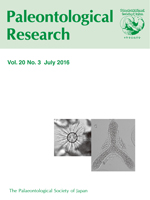The stable carbon (δ13C) and oxygen isotopes (δ18O) of planktic foraminiferal tests have been widely used as proxies in paleoceanography and paleoclimatology. The ontogenetic isotopic profiles of foraminifers are also thought to record ecological information about species, such as changes in habitat depth and symbiotic relationships. However, isotopic profiles during “individual ontogeny” have rarely been examined. In this study, we report the ontogenetic isotopic information for three net-collected modern species, Globigerinoides sacculifer, Neogloboquadrina dutertrei, and Globorotalia inflata, together with several in situ oceanographic parameters of the water column in Sagami Bay, Japan (seawater temperature, salinity, nutrients, chlorophyll a content, δ13C of dissolved inorganic carbon [DIC], and δ18O of seawater). We examined the ontogenetic profiles of the foraminifers with chamber dissection and chamber-by-chamber analyses of δ13C and δ18O using a specially designed continuous-flow mass spectrometry system. The ontogenetic δ18O profiles showed overall 18O-enrichment in all three species, suggesting their ontogenetic migration toward deeper habitats. When these records were compared with the physicochemical profiles of the water column, all the ontogenetic records began within the uppermost thermocline or shallower, corresponding to the depth of relatively high chlorophyll content. Later in ontogeny, Gs. sacculifer and N. dutertrei migrated to the bottom of the level of maximum chlorophyll, whereas Gr. inflata descended to a depth of 200 m. The deviations of foraminiferal δ13C from the δ13C of DIC were largest in the juvenile stages, but were near zero at a test mass of ca. 10 μg for all three species. Contrary to the subsequent asymptotic profiles of this deviation in N. dutertrei and Gr. inflata, Gs. sacculifer alone showed a subsequent increase, of up to 1.0‰, reflecting its symbiotic relationship. We conclude that a certain ontogenetic test mass, in this case of around 10 μg, can be assigned to a preferable size class of foraminifers from which to reconstruct the paleo-δ13C of DIC in the water column, regardless of the species ecology.
How to translate text using browser tools
1 July 2016
Individual Migration Pathways of Modern Planktic Foraminifers: Chamber-by-Chamber Assessment of Stable Isotopes
Haruka Takagi,
Kazuyoshi Moriya,
Toyoho Ishimura,
Atsushi Suzuki,
Hodaka Kawahata,
Hiromichi Hirano
ACCESS THE FULL ARTICLE
<
Previous Article
|

Paleontological Research
Vol. 20 • No. 3
July 2016
Vol. 20 • No. 3
July 2016
habitat depth
ontogenetic migration
planktic foraminifers
Stable carbon isotope
stable oxygen isotope




